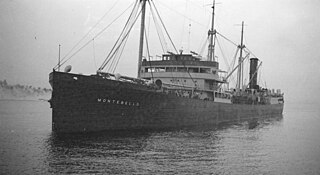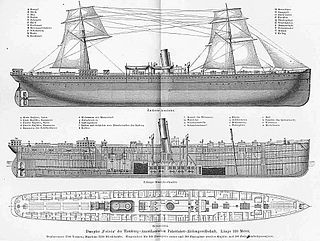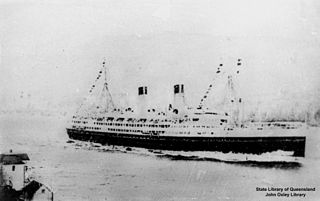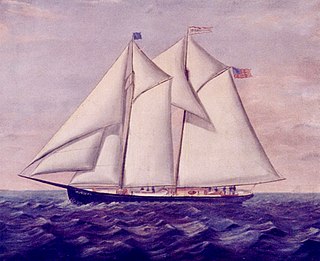
The St. Lawrence Seaway is a system of locks, canals, and channels in Canada and the United States that permits oceangoing vessels to travel from the Atlantic Ocean to the Great Lakes of North America, as far inland as Duluth, Minnesota, at the western end of Lake Superior. The seaway is named for the St. Lawrence River, which flows from Lake Ontario to the Atlantic Ocean. Legally, the seaway extends from Montreal, Quebec, to Lake Erie, and includes the Welland Canal. Ships from the Atlantic Ocean are able to reach ports in all five of the Great Lakes, via the Great Lakes Waterway.

The Johnny Rockets Group Inc. is an American restaurant franchise whose themed decor is based upon 1950s diner-style restaurants. Décor includes Coca-Cola advertising, featuring nearly life-size cardboard illustrations of women in World War II armed services uniforms, individual jukebox stations, chrome accents and red vinyl seats.

HMCS Cape Breton was a Royal Canadian Navy Cape-class maintenance ship. Originally built for the Royal Navy as HMS Flamborough Head in 1944, she was transferred in 1952. Upon her commissioning she was the second ship to bear the name Cape Breton. She served operationally from 1953–1964, when she was laid up. She was used as a floating machine shop until the late-1990s, before being sold for use as an artificial reef off the coast of British Columbia.

USAT Brigadier General M. G. Zalinski was a U.S. Army transport ship that served in World War II. It sank in 1946 in the Grenville Channel in British Columbia's Inside Passage. The crew were rescued by a tug boat and the SS Catala passenger steamer, but the cargo of bombs and oil went down with the ship.

HMCS Lady Evelyn was a commissioned patrol boat of the Royal Canadian Navy during the First World War. Originally built as a passenger liner, Deerhound, she was acquired in 1907 by the Canadian government and renamed Lady Evelyn for use by the post office. After the war, she was sold for civilian service and scrapped in 1936.

Montebello was a steam oil tanker built in 1920–1921 by the Southwestern Shipbuilding Co. of San Pedro for Union Oil Company with the intention of carrying oil and petroleum products along the West Coast of the United States and Canada as well as between the United States and Chile. In December 1941 the tanker was sunk on one of her regular trips by the Japanese submarine I-21.

The Hilma Hooker is a shipwreck in Bonaire in the Caribbean Netherlands. It is a popular wreck diving site.

Trans-Asia Shipping Lines, Incorporated (TASLI) is a shipping company based in Cebu City, Philippines. It was incorporated on March 25, 1974, under the name of Solar Shipping Lines, Inc. The Chairman of the company is Dennis A. Uy. Trans-Asia Shipping Lines is now managed by the Chelsea Logistics, Corp.

SS Kyle is a 220 feet (67 m) steam ship that is aground in the harbour of the Town of Harbour Grace, Newfoundland and Labrador, Canada. She ran ashore in February 1967. Intended to transport supplies and provide transportation from Carbonear to Labrador, she was also used to transport infantry to Canada during World War II. After her grounding on the shores of Riverhead, Harbour Grace, she has had several owners, from the Earle Brothers Freighting Company, Dominion Metals, and the Government of Newfoundland. Plans to have the vessel moved to the town of Salmon Cove, Newfoundland, and turned into a museum were later aborted due to financial implications.
SS Canadian Constructor was a 7,178 GRT refrigerated ship built in 1922 by Halifax Shipyards Ltd in Nova Scotia.

SS Princess Mary was a passenger vessel in the coastal service fleet of the Canadian Pacific Railway (CPR) during the first half of the 20th century.
SS Robin Doncaster was a 7,101 GRT cargo liner that was built in 1940 as a Type C2-S cargo ship by Bethlehem Steel Co, Sparrows Point, Maryland, United States for the United States Maritime Commission (USMC). On completion in April 1941, she was transferred to the Ministry of War Transport (MoWT) and renamed Empire Curlew. In 1942, she was transferred to the USMC, regaining her former name Robin Doncaster. She was rebuilt as a troop transport, and entered service with the War Shipping Administration in January 1944. She was returned to the USMC in April 1946 and was sold to Seas Shipping Co Inc in 1948. In 1957, she was sold to Isbrandtsen Lines and was renamed Flying Gull. Sold to American Export Lines in 1962, she served until she was scrapped in 1968.

The SS Silesia was a late 19th-century Hamburg America Line passenger and cargo ship that ran between the European ports of Hamburg, Germany and Le Havre, France to Castle Garden and later Ellis Island, New York transporting European immigrants, primarily Russian, Prussian, Hungarian, German, Austrian, Italian, and Danish individuals and families. Most passengers on this route were manual laborers, including stonecutters, locksmiths, farmers, millers, upholsterers, confectioners, and tailors, though physicians and other professionals also bought passage on her.

Princess Royal was a wooden steamship built in 1907 for the Canadian Pacific Railway Coast Service. The ship operated on the coasts of British Columbia, south east Alaska, and northern Puget Sound until 1933, when the ship was sold for scrapping.

MV Aorangi was a transpacific ocean liner and refrigerated cargo ship. She was launched in 1924 in Scotland and scrapped in 1953. Her regular route was between Sydney and Vancouver via Auckland, Suva and Honolulu.

Orion was constructed as a whale catcher in 1904, in Christiana, Norway. She was a steam-powered vessel, 91 feet (28 m) long, 17 feet (5.2 m) wide, displacing 109 tonnes. Robert Lloyd Webb, author of a book on commercial whaling in the Pacific Northwest, wrote that she was the first steam-powered chaser boat in British Columbia.
RMS St Helena was a passenger-cargo liner, built in 1963 as Northland Prince, operated by the St. Helena Shipping Company that operated between Britain and South Africa via the British colony of Saint Helena between 1978 and 1990.


The Thomas F. Bayard was a 19th-century Delaware River pilot schooner built by C. & R. Poillon shipyard in 1880. She spent sixteen years as a pilot boat before being sold during the Yukon Gold Rush in 1897. She was sold again in 1906 for Seal hunting, then purchased by the Department of Marine & Fisheries where she guided freighters into New Westminster, British Columbia for 43 years. She was then acquired by the Vancouver Maritime Museum in 1978. When she sank at her mooring in 2002, the International Yacht Restoration School, Mystic Seaport and the Vancouver Maritime Museum, removed the vessel in pieces for the archeological teams to study and document the remains of her hull. The Thomas F. Bayard Collection, at the Vancouver Maritime Museum, contains the documents, history and preservation efforts.

















